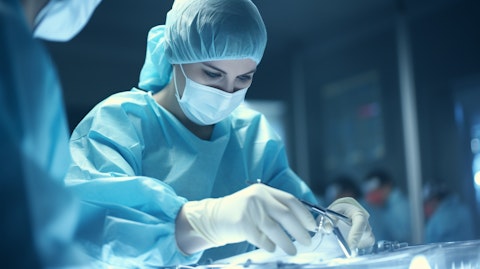Harvard Bioscience, Inc. (NASDAQ:HBIO) Q2 2025 Earnings Call Transcript August 11, 2025
Harvard Bioscience, Inc. beats earnings expectations. Reported EPS is $-0.01, expectations were $-0.025.
Operator: Good day, and welcome to the Second Quarter 2025 Harvard Bioscience Earnings Conference Call. [Operator Instructions] Please note, this event is being recorded. I would now like to turn the conference over to Taylor Krafchik, Senior Vice President at Ellipsis TA. Please go ahead.
Taylor Krafchik: Thank you, operator, and good morning, everyone. Thank you for joining the Harvard Bioscience Second Quarter 2025 Earnings Conference Call. Leading the call today will be John Duke, President and Chief Executive Officer; and Mark Frost, Interim Chief Financial Officer. In conjunction with today’s recorded call, we have provided a presentation that will be referenced during our remarks that is posted to the Investor Relations section of our website at investor.harvardbioscience.com. Please note that statements made today in discussion that are not historical facts, including statements on management’s expectations of future events or future financial performance are forward-looking statements and are made pursuant to the safe harbor provisions of the Private Securities Litigation Reform Act of 1995.
These forward-looking statements reflect the current views of Harvard Bioscience Management and Harvard Bioscience assumes no obligation to update or revise any forward-looking statements. Actual results may differ materially from those expressed or implied. Please refer to today’s press release, the Harvard Bioscience Form 10-K and other filings with the Securities and Exchange Commission for additional disclosures on forward-looking statements and the risks, uncertainties and contingencies associated therewith. During the call, management will also reference certain non- GAAP financial measures, which can be useful in evaluating the company’s operations related to our financial condition and results. These non-GAAP measures are intended to supplement GAAP financial information and should not be considered a substitute Reconciliations of GAAP to non-GAAP measures are provided in today’s earnings press release.
I will now turn the call over to Mark. Mark, please go ahead.
Mark T. Frost: Thank you, Taylor. Before discussing our results, I’d like to welcome John, our recently appointed President and CEO. John has significant experience in leading and growing businesses in the life science industry, and I along with the entire Harvard Bioscience team, look forward to working with him to achieve our goals. I will turn it over to him after my remarks, so he can walk through his initial observations and the key priorities that we are focused on. I’ll now move to our second quarter 2025 financial results, the details of which can be found on Slide 3 of the earnings presentation that we posted to our IR site. On Slide 3, revenue was $20.5 million, below $23.1 million in the prior year, but ahead of our guidance of $18 million to $20 million, primarily because of higher Chinese shipments.
Gross margin was 56.4% versus 57.2% in 2024 and was towards the high end of our guidance of 55% to 57%. Operating expenses declined $2 million from prior year, driven by actions taken in 2024 and the first quarter of 2025 to one move to, one, U.S. ERP system, two, lean out our SG&A organization; and three, reprioritize our NPI projects. This led to an improvement in adjusted operating income of $1 million versus $0.8 million in quarter 2 ’24. Quarter 2 adjusted EBITDA was $1.5 million versus $1.3 million in quarter 2 ’24 with the major driver being the reduction in operating expenses, which more than offset the volume impact from the lower year-over-year revenue. Now looking at Slide 4, I will outline the revenue results for the quarter by product family and region.
Overall revenues in the second quarter showed a slight decline from quarter 1, finishing at $20.5 million compared to $21.8 million in the prior quarter. Now turning to the geographical results, starting with the Americas. Revenue in the second quarter declined sequentially by 5.4% and were down 11.7% versus revenues in the second quarter of last year. As shown in the light blue on the slide, CMT had sequential growth driven by MEA’s organoids. The year-over-year decreases were caused primarily by a lack of budget clarity for academics and NIH. Our preclinical sales declined sequentially and year-over-year due to lower academic sales related to the aforementioned budget clarity challenge for NIH academics. Now moving on to Europe. Overall revenue in Europe in the second quarter increased 9% sequentially, reflecting stronger academic shipments.
Compared to last year’s Q2, European revenues were largely flat. Cellular and Molecular sales increased sequentially and was flat year-over-year. Our quarter 2 preclinical sales increased sequentially and year-over-year, driven by higher pharma sales. Now moving to China and the Asia Pacific, which has been negatively impacted by macro uncertainty over tariffs. Overall, in the second quarter, APAC revenue was down both sequentially and year-over-year by over 25% due in large part to the tariff situation with China. Orders and shipments halted in April, but gradually returned to more normal behavior after the tentative agreement of a 10% tariff level. Cellular and Molecular APAC products declined sequentially and year-over-year. Preclinical APAC products also declined sequentially and year-over-year due to tariffs.
Now I’ll move to Slide 5 to discuss further financial metrics. Looking at gross margin first. Gross margin during quarter 2, 2025 was 56.4% compared to 57.2% in quarter 2, 2024, but up 40 basis points from the 56% in the prior quarter despite the lower revenue. The gross margin decline compared to last year quarter 2 was mainly due to lower absorption of fixed manufacturing overhead costs on a reduction in volume. The sequential margin expansion was due to actions we took to reduce the manufacturing organization for the expected lower revenue volume. Now if you refer to the top right graph, our adjusted EBITDA during quarter 2 increased to $1.5 million versus $1.3 million in last year’s second quarter. Compared to the prior year quarter 2, reduced gross profit of $1.7 million was fully offset by lower operating expenses of $2 million.

Now moving to the bottom left, where we both show — where we show both reported and adjusted loss earnings per share. As mentioned in the past, I’ll remind you that typically, the differences between GAAP EPS and adjusted EPS is the impact of stock compensation, amortization and depreciation. These differences between net loss and adjusted EBITDA are highlighted in the reconciliation tables on Slide 10 and are all noncash items. Now moving to the bottom middle graph. Year-to-date cash flow operations were strong at $5.7 million compared to $0.6 million in the same period with $2.8 million of operating cash generated in the second quarter. The primary driver for improved cash flow from operations was working capital management progress from both AR and inventory as well as operating expense reductions.
Net debt was down over $4 million from year-end to $27.9 million from $32 million. This reflects our quarterly principal payment of $1 million and improved operating cash flow. Now with respect to our credit facility, we negotiated an amendment with our bank group. Key elements of the agreement are: first, an extension of refinance timing to December 5, close to the maturity date of the facility. Waiver default on refinancing milestones and financial covenants relating to leverage, fixed interest coverage. Thirdly, elimination of testing of financial covenants for quarter 3, except for liquidity, which is now $3 million; and fourth, an increase in the SOFR adder to 700 basis points and an amendment fee of 100 basis points, which is primarily paid once debt is repaid.
We believe the extension provides us with sufficient time to identify and execute a transaction to refinance and pay down the existing debt. More detail is provided in the 10-Q, which will be filed after market today. I’ll now move to Slide 7 to discuss our outlook for quarter 3. Now supported by our second quarter revenue performance as well as a strong start on orders in the third quarter, we are guiding to a range of $19 million to $21 million of revenue. With that, we expect a corresponding improvement in gross margin from the higher volume and are guiding to a gross margin range of 56% to 58%. This guidance shows our continuous progress in stabilizing our business as well as our prudent financial discipline. I’ll now turn the call over to John.
John?
John Duke: Thanks, Mark. Good morning, and thank you for joining us today. I’m pleased to be speaking to you for the first time since my recent appointment as President and CEO. On behalf of our Board of Directors and the entire workforce, I would like to thank Jim Green for his leadership and many contributions he’s made to the company during the past 6 years. Let me start by sharing how encouraged I am by what I’ve seen since stepping into the role 2 weeks ago. Harvard Bioscience has a strong operating team, a culture committed to advancing science and an innovation pipeline that positions us well for long-term growth. Since joining the company, I’ve actively engaged with employees, customers and partners with the goal of aligning the organization around a clear set of priorities.
Our focus for the remainder of 2025 is clear. Number one, maintain financial discipline by continuing to deliver cost efficiencies and generate positive cash flow. Number two, accelerate product adoption by leveraging our strong product portfolio to position the company for long-term growth; and number three, strengthen our capital structure by completing the refinance process to invest in our future growth. As Mark indicated in his remarks, we made progress in each area during the second quarter. First, on maintaining financial discipline. The fundamentals of the business remain intact as we delivered second quarter revenue results of $20.5 million, which was above our guidance of $18 million to $20 million. We reported gross margin of 56.4%, reduced operating expenses and managed our costs.
These efforts resulted in $1.5 million of adjusted EBITDA and $2.8 million of operating cash flow. Looking ahead, our third quarter guidance of $19 million to $21 million of revenue and 56% to 58% gross margin reflects continued financial discipline. With respect to how macro conditions may impact our operations, NIH funding delays continue to extend academic purchasing cycles. But budgets remain in place, and we expect improvement into 2026 as procurement normalizes. As for tariffs, uncertainty remains in the market, but we believe the worst is behind us. We executed well in Q2 and are optimistic that greater clarity will emerge in the second half of the year. Second, on accelerating product adoption. Our new product pipeline covers multiple high-growth platforms.
We began shipments of the SoHo Telemetry platform, adding cardiac and neuromonitoring capabilities. We progressed our VivaMARS automation pilot with Labcorp, opening new CRO opportunities. We achieved a key milestone in BTX bioproduction with $1 million in consumable revenue with additional applications underway. And we continue to expand adoption of our Mesh MEA organoid platform, driven by regulatory support for alternative testing methods and strong interest from academic, CRO and biopharma customers. All this positions us for future growth in high-value markets with structural tailwinds. Third, on our capital structure. As Mark noted, we entered into an amendment to our credit agreement. This reflects our commitment to strengthening the balance sheet and positioning the business for long-term success.
Our priority is to restructure our debt obligations and use our balance sheet to invest in the growth of our business. This amendment provides us with additional time to continue working towards that goal. In closing, 2025 remains a pivotal year focused on execution and financial discipline. Our priorities are to continue to stabilize our core business and restructure our balance sheet to build sustainable sales and profitability. I’m confident this will position us for revenue growth and margin expansion in 2026 and beyond. I truly appreciate your continued support and look forward to engaging with you going forward. I’ll now turn the call over to the operator so we can take your questions.
Q&A Session
Follow Harvard Bioscience Inc (NASDAQ:HBIO)
Follow Harvard Bioscience Inc (NASDAQ:HBIO)
Receive real-time insider trading and news alerts
Operator: Our first question comes from Paul Knight with KeyBanc.
Paul Richard Knight: You have until December 5 on a refinance. What do you expect — what’s total debt going to be at that point in time?
Mark T. Frost: Sure, Paul. We would expect to continue to pay down the debt, which is $1 million a quarter. So our debt would likely be around $33 million at that point in time.
Paul Richard Knight: Okay. And I’m guessing terms are pretty much what would it be like BB, B type terms?
Mark T. Frost: Yes. To answer that question, that would be our expectation. We think the environment may be slightly improved in view of our better results and seeing more clarity on the macro front from a tariff and NIH standpoint.
Paul Richard Knight: And regarding the NIH, it does seem like we may get reprieve like the first year of the Trump administration. And if the budget is actually up 80 bps like the Senate committee may want. What do you think happens? Is there going to be a budget burn through October of this year after a September recess — this recess is over, and we might have a bill in September? Or do you think that kind of NIH outlay while it improves, would be extending into early next year? What are your thoughts around how a better budget could unfold at NIH?
John Duke: I think there’s a lot of different scenarios how things could unfold at NIH. We — what we have seen is that the academic purchasing cycles have been extended, but the budgets remain in place. I mean, clearly, government — sales to government NIH are a reasonable portion of our business in the United States. And if things were to improve into 2026, that would clearly benefit our business. But we have a cost structure in place today, which we feel good about, such that if there were no significant changes, we would be able to manage our business well.
Paul Richard Knight: And last would be what’s your China exposure today? What — and again, what did China do in the quarter?
Mark T. Frost: Sure, yes. The China business is about 10% of our revenue. And as I indicated on the call, it did go almost to 0 in April, but we’re now back to more normal run rate as we saw in ’25. And if we stay at the 10% tariff, that would be our continued expectation.
Operator: Our next question comes from Bruce Jackson with the Benchmark Company.
Bruce David Jackson: Just to follow up on the NIH questions. Do you have any sense of whether or not there could be any changes to the types of projects getting funded and how you’re positioned? So for example, you’ve got a neuroscience platform that looks really interesting. And do you think that, that could get a boost under the new budget in 2026?
John Duke: We do have a strong neuroscience platform and specifically our Mesh MEA towards organoids. We would be encouraged clearly, if the NIH budget when it is released for 2026, if there’s an emphasis in that there, that would definitely enhance some of our products, which are in the new product portfolio.
Bruce David Jackson: Okay. And then also to follow up on China. So you said we’ve got some sense of clarity on the macro and some stability with regard to tariffs. Are there any other macro factors that you’re watching right now in order to gain a higher sense of confidence in the forward macro?
Mark T. Frost: Sure. I’ll take that, Bruce. It’s Mark. It’s a good question. The one open area is the European tariffs. And right now, we can all see we’re at 15%, but we are seeing some volatility still in some of the other countries. I think — we have to see if that settles out. I think the one thing for our business is we do have a number of European operations. So we do have additional options to move country of origin if that holds true or if there’s further volatility on the European side.
Bruce David Jackson: Okay. Okay. Great. And then last question, getting back to the Mesh MEA products. You’ve been working with some academic institutions, hoping maybe to get some publications going. Anything to look forward to in the next couple of quarters?
John Duke: Well, there is a big show, the Society of Neuroscience in November. And at that show, you’ll see some information, which we’re going to be sharing and look forward to those academic results.
Operator: I’m showing no further questions at this time. This does conclude the program. You may now disconnect. Everyone, have a great day.
Follow Harvard Bioscience Inc (NASDAQ:HBIO)
Follow Harvard Bioscience Inc (NASDAQ:HBIO)
Receive real-time insider trading and news alerts




